Strategic HR Planning and Talent Development Report
VerifiedAdded on 2023/06/08
|12
|3611
|159
Report
AI Summary
This report provides a comprehensive overview of human resource (HR) planning, focusing on strategic elements and practical applications within the context of Sainsbury's. It begins with an executive summary and introduction, outlining the significance of HR planning in aligning employee performance with organizational objectives. The main body delves into the meaning, best practices, and advantages and disadvantages of HR planning, followed by an analysis of the HR planning process and methodologies. The report explores internal and external factors influencing future staffing needs, considering supply and demand dynamics in the current market. It also provides recommendations for talent development, which are integral to forming a robust HR business proposal. The report concludes with a summary of key findings and offers valuable insights for effective human resource management.

Managing Human
Resource
Resource
Paraphrase This Document
Need a fresh take? Get an instant paraphrase of this document with our AI Paraphraser
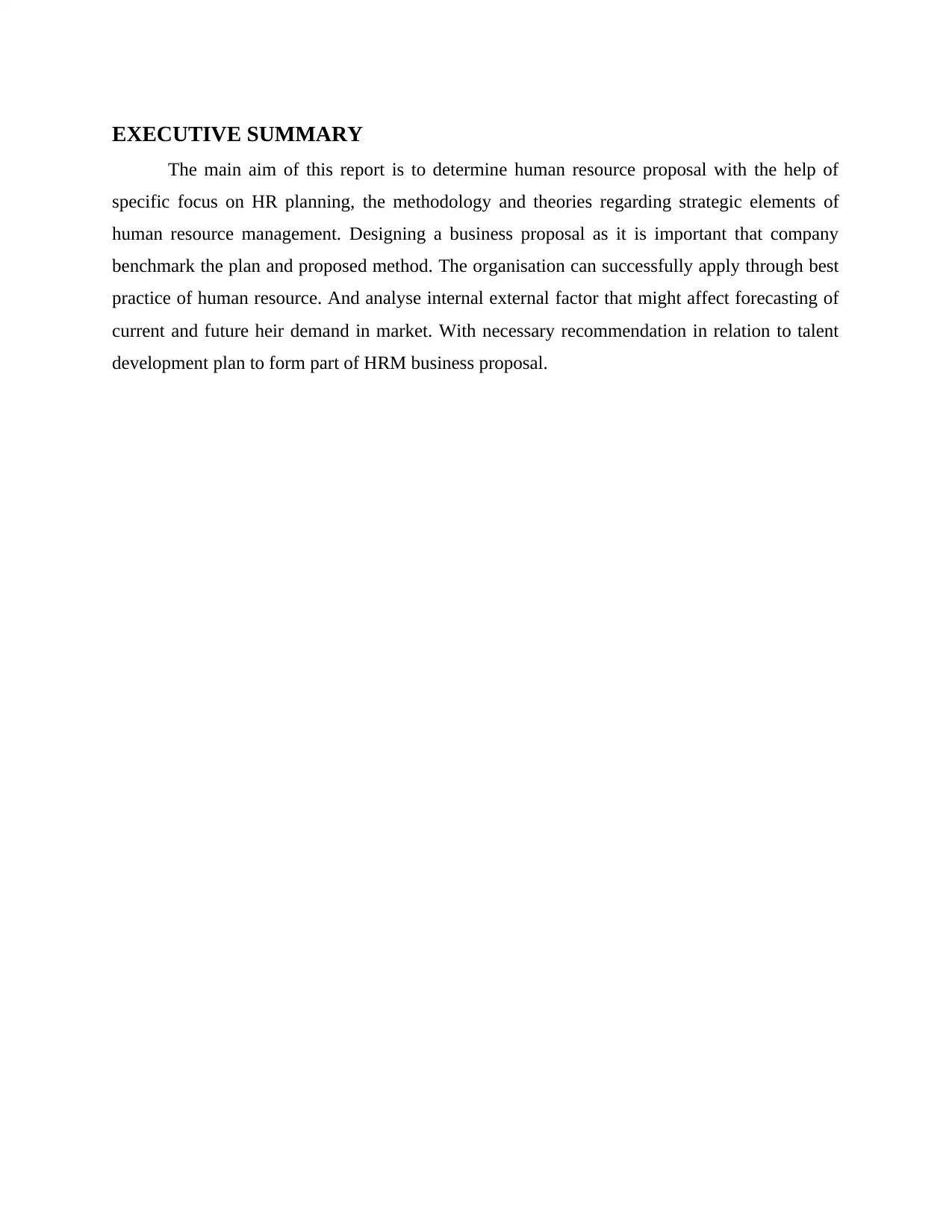
EXECUTIVE SUMMARY
The main aim of this report is to determine human resource proposal with the help of
specific focus on HR planning, the methodology and theories regarding strategic elements of
human resource management. Designing a business proposal as it is important that company
benchmark the plan and proposed method. The organisation can successfully apply through best
practice of human resource. And analyse internal external factor that might affect forecasting of
current and future heir demand in market. With necessary recommendation in relation to talent
development plan to form part of HRM business proposal.
The main aim of this report is to determine human resource proposal with the help of
specific focus on HR planning, the methodology and theories regarding strategic elements of
human resource management. Designing a business proposal as it is important that company
benchmark the plan and proposed method. The organisation can successfully apply through best
practice of human resource. And analyse internal external factor that might affect forecasting of
current and future heir demand in market. With necessary recommendation in relation to talent
development plan to form part of HRM business proposal.

Table of Contents
EXECUTIVE SUMMARY ............................................................................................................2
INTRODUCTION...........................................................................................................................1
MAIN BODY...................................................................................................................................1
Meaning, explanation, best practice & analysis of HR planning with its advantages and
disadvantages..........................................................................................................................1
Human resource planning process and HR planning methodology.......................................4
Internal and external factors in terms of future staffing needs. Supply and demand issues
related to current market. Recommendation of talent development.......................................6
CONCLUSION................................................................................................................................8
REFERENCES ...............................................................................................................................9
EXECUTIVE SUMMARY ............................................................................................................2
INTRODUCTION...........................................................................................................................1
MAIN BODY...................................................................................................................................1
Meaning, explanation, best practice & analysis of HR planning with its advantages and
disadvantages..........................................................................................................................1
Human resource planning process and HR planning methodology.......................................4
Internal and external factors in terms of future staffing needs. Supply and demand issues
related to current market. Recommendation of talent development.......................................6
CONCLUSION................................................................................................................................8
REFERENCES ...............................................................................................................................9
⊘ This is a preview!⊘
Do you want full access?
Subscribe today to unlock all pages.

Trusted by 1+ million students worldwide
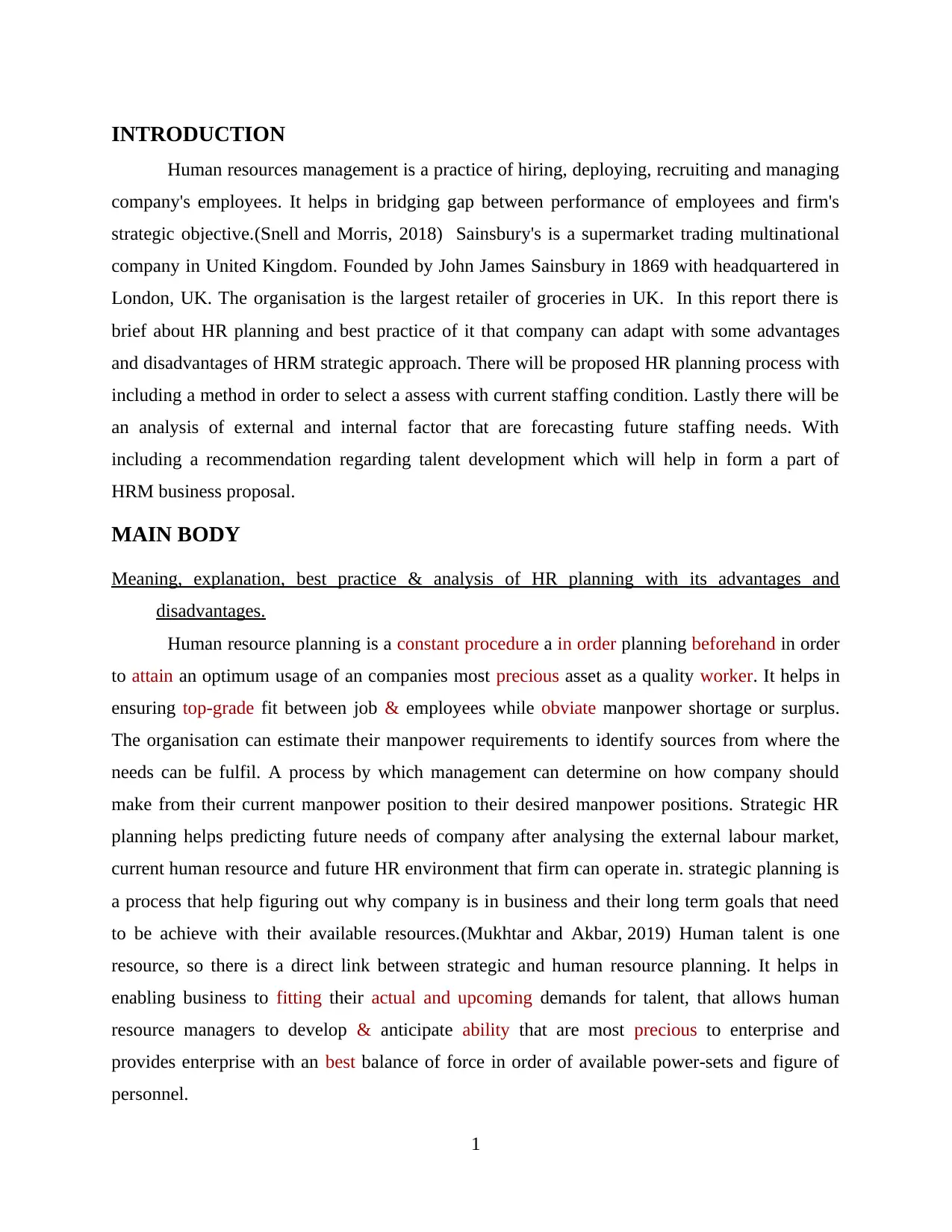
INTRODUCTION
Human resources management is a practice of hiring, deploying, recruiting and managing
company's employees. It helps in bridging gap between performance of employees and firm's
strategic objective.(Snell and Morris, 2018) Sainsbury's is a supermarket trading multinational
company in United Kingdom. Founded by John James Sainsbury in 1869 with headquartered in
London, UK. The organisation is the largest retailer of groceries in UK. In this report there is
brief about HR planning and best practice of it that company can adapt with some advantages
and disadvantages of HRM strategic approach. There will be proposed HR planning process with
including a method in order to select a assess with current staffing condition. Lastly there will be
an analysis of external and internal factor that are forecasting future staffing needs. With
including a recommendation regarding talent development which will help in form a part of
HRM business proposal.
MAIN BODY
Meaning, explanation, best practice & analysis of HR planning with its advantages and
disadvantages.
Human resource planning is a constant procedure a in order planning beforehand in order
to attain an optimum usage of an companies most precious asset as a quality worker. It helps in
ensuring top-grade fit between job & employees while obviate manpower shortage or surplus.
The organisation can estimate their manpower requirements to identify sources from where the
needs can be fulfil. A process by which management can determine on how company should
make from their current manpower position to their desired manpower positions. Strategic HR
planning helps predicting future needs of company after analysing the external labour market,
current human resource and future HR environment that firm can operate in. strategic planning is
a process that help figuring out why company is in business and their long term goals that need
to be achieve with their available resources.(Mukhtar and Akbar, 2019) Human talent is one
resource, so there is a direct link between strategic and human resource planning. It helps in
enabling business to fitting their actual and upcoming demands for talent, that allows human
resource managers to develop & anticipate ability that are most precious to enterprise and
provides enterprise with an best balance of force in order of available power-sets and figure of
personnel.
1
Human resources management is a practice of hiring, deploying, recruiting and managing
company's employees. It helps in bridging gap between performance of employees and firm's
strategic objective.(Snell and Morris, 2018) Sainsbury's is a supermarket trading multinational
company in United Kingdom. Founded by John James Sainsbury in 1869 with headquartered in
London, UK. The organisation is the largest retailer of groceries in UK. In this report there is
brief about HR planning and best practice of it that company can adapt with some advantages
and disadvantages of HRM strategic approach. There will be proposed HR planning process with
including a method in order to select a assess with current staffing condition. Lastly there will be
an analysis of external and internal factor that are forecasting future staffing needs. With
including a recommendation regarding talent development which will help in form a part of
HRM business proposal.
MAIN BODY
Meaning, explanation, best practice & analysis of HR planning with its advantages and
disadvantages.
Human resource planning is a constant procedure a in order planning beforehand in order
to attain an optimum usage of an companies most precious asset as a quality worker. It helps in
ensuring top-grade fit between job & employees while obviate manpower shortage or surplus.
The organisation can estimate their manpower requirements to identify sources from where the
needs can be fulfil. A process by which management can determine on how company should
make from their current manpower position to their desired manpower positions. Strategic HR
planning helps predicting future needs of company after analysing the external labour market,
current human resource and future HR environment that firm can operate in. strategic planning is
a process that help figuring out why company is in business and their long term goals that need
to be achieve with their available resources.(Mukhtar and Akbar, 2019) Human talent is one
resource, so there is a direct link between strategic and human resource planning. It helps in
enabling business to fitting their actual and upcoming demands for talent, that allows human
resource managers to develop & anticipate ability that are most precious to enterprise and
provides enterprise with an best balance of force in order of available power-sets and figure of
personnel.
1
Paraphrase This Document
Need a fresh take? Get an instant paraphrase of this document with our AI Paraphraser

The objectives of human resources planning.
In context to Sainsbury's it is important for company to develop a strategic human
resource planning in order to achieve companies goals and objectives. As the brand is
multinational it become necessary to increase the requirement of labour force for better
management of the organisation. (Aravindakumar,2020) It provide a process through which
developing, controlling forecasting by company in order to ensure that they has a right number
and kind of staff with regard to their competencies and skills. The objectives of HR planning are
mentioned below.
Provide information- The information that is attained through HRP is quite important in
order to identify unutilised and surplus human resource. It also delivers a comprehensive
skills, which helps in decision-making.(Zubek, 2020) Through this manner HRP supply
data that can be used for other role of management.
Effective utilisation of HR- Designing for human resource is primary obligation of
administration in order to check utilisation of existing and coming workforce effectively.
Labour force planning is a complementary to companies planning process.
Economic development- workforce planning is needed for economic improvement. As
it helps in generate occupation in geographical talent & also at a education level.
Determine labour force gap- workforce planning can be analyse the space in existent
labour so that suitable training programmes can be formulated for building specific skills
that are required in future.
Forecast requirement of human resource- To influence upcoming human resource that
is need in company. With the lack of such planning it will become difficult to have a
employment of right kind of people at right time.
Human resource best practice.
Planning is a process in order to develop a set of decision for future action. The actions
that are required to initiated as exogenous for HR planning are generally classified as economic
development and employment & opportunity.(Ospina&Bermeo, 2021) It is an important aspects
of workforce administration and management. Best practice is a set of procedure and action that
work existence for human resource management. There are various types of HR best practices,
some them are mentioned below.
2
In context to Sainsbury's it is important for company to develop a strategic human
resource planning in order to achieve companies goals and objectives. As the brand is
multinational it become necessary to increase the requirement of labour force for better
management of the organisation. (Aravindakumar,2020) It provide a process through which
developing, controlling forecasting by company in order to ensure that they has a right number
and kind of staff with regard to their competencies and skills. The objectives of HR planning are
mentioned below.
Provide information- The information that is attained through HRP is quite important in
order to identify unutilised and surplus human resource. It also delivers a comprehensive
skills, which helps in decision-making.(Zubek, 2020) Through this manner HRP supply
data that can be used for other role of management.
Effective utilisation of HR- Designing for human resource is primary obligation of
administration in order to check utilisation of existing and coming workforce effectively.
Labour force planning is a complementary to companies planning process.
Economic development- workforce planning is needed for economic improvement. As
it helps in generate occupation in geographical talent & also at a education level.
Determine labour force gap- workforce planning can be analyse the space in existent
labour so that suitable training programmes can be formulated for building specific skills
that are required in future.
Forecast requirement of human resource- To influence upcoming human resource that
is need in company. With the lack of such planning it will become difficult to have a
employment of right kind of people at right time.
Human resource best practice.
Planning is a process in order to develop a set of decision for future action. The actions
that are required to initiated as exogenous for HR planning are generally classified as economic
development and employment & opportunity.(Ospina&Bermeo, 2021) It is an important aspects
of workforce administration and management. Best practice is a set of procedure and action that
work existence for human resource management. There are various types of HR best practices,
some them are mentioned below.
2
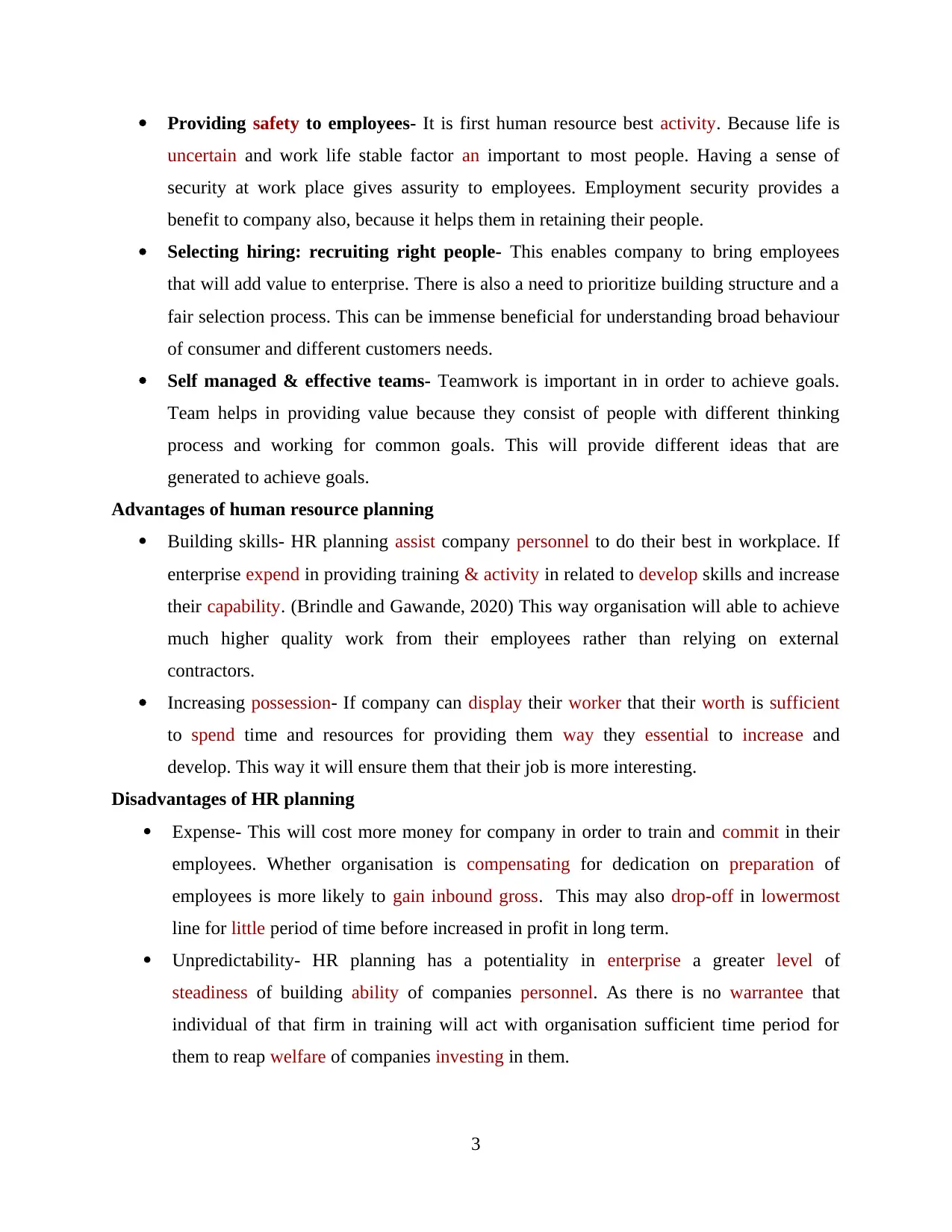
Providing safety to employees- It is first human resource best activity. Because life is
uncertain and work life stable factor an important to most people. Having a sense of
security at work place gives assurity to employees. Employment security provides a
benefit to company also, because it helps them in retaining their people.
Selecting hiring: recruiting right people- This enables company to bring employees
that will add value to enterprise. There is also a need to prioritize building structure and a
fair selection process. This can be immense beneficial for understanding broad behaviour
of consumer and different customers needs.
Self managed & effective teams- Teamwork is important in in order to achieve goals.
Team helps in providing value because they consist of people with different thinking
process and working for common goals. This will provide different ideas that are
generated to achieve goals.
Advantages of human resource planning
Building skills- HR planning assist company personnel to do their best in workplace. If
enterprise expend in providing training & activity in related to develop skills and increase
their capability. (Brindle and Gawande, 2020) This way organisation will able to achieve
much higher quality work from their employees rather than relying on external
contractors.
Increasing possession- If company can display their worker that their worth is sufficient
to spend time and resources for providing them way they essential to increase and
develop. This way it will ensure them that their job is more interesting.
Disadvantages of HR planning
Expense- This will cost more money for company in order to train and commit in their
employees. Whether organisation is compensating for dedication on preparation of
employees is more likely to gain inbound gross. This may also drop-off in lowermost
line for little period of time before increased in profit in long term.
Unpredictability- HR planning has a potentiality in enterprise a greater level of
steadiness of building ability of companies personnel. As there is no warrantee that
individual of that firm in training will act with organisation sufficient time period for
them to reap welfare of companies investing in them.
3
uncertain and work life stable factor an important to most people. Having a sense of
security at work place gives assurity to employees. Employment security provides a
benefit to company also, because it helps them in retaining their people.
Selecting hiring: recruiting right people- This enables company to bring employees
that will add value to enterprise. There is also a need to prioritize building structure and a
fair selection process. This can be immense beneficial for understanding broad behaviour
of consumer and different customers needs.
Self managed & effective teams- Teamwork is important in in order to achieve goals.
Team helps in providing value because they consist of people with different thinking
process and working for common goals. This will provide different ideas that are
generated to achieve goals.
Advantages of human resource planning
Building skills- HR planning assist company personnel to do their best in workplace. If
enterprise expend in providing training & activity in related to develop skills and increase
their capability. (Brindle and Gawande, 2020) This way organisation will able to achieve
much higher quality work from their employees rather than relying on external
contractors.
Increasing possession- If company can display their worker that their worth is sufficient
to spend time and resources for providing them way they essential to increase and
develop. This way it will ensure them that their job is more interesting.
Disadvantages of HR planning
Expense- This will cost more money for company in order to train and commit in their
employees. Whether organisation is compensating for dedication on preparation of
employees is more likely to gain inbound gross. This may also drop-off in lowermost
line for little period of time before increased in profit in long term.
Unpredictability- HR planning has a potentiality in enterprise a greater level of
steadiness of building ability of companies personnel. As there is no warrantee that
individual of that firm in training will act with organisation sufficient time period for
them to reap welfare of companies investing in them.
3
⊘ This is a preview!⊘
Do you want full access?
Subscribe today to unlock all pages.

Trusted by 1+ million students worldwide
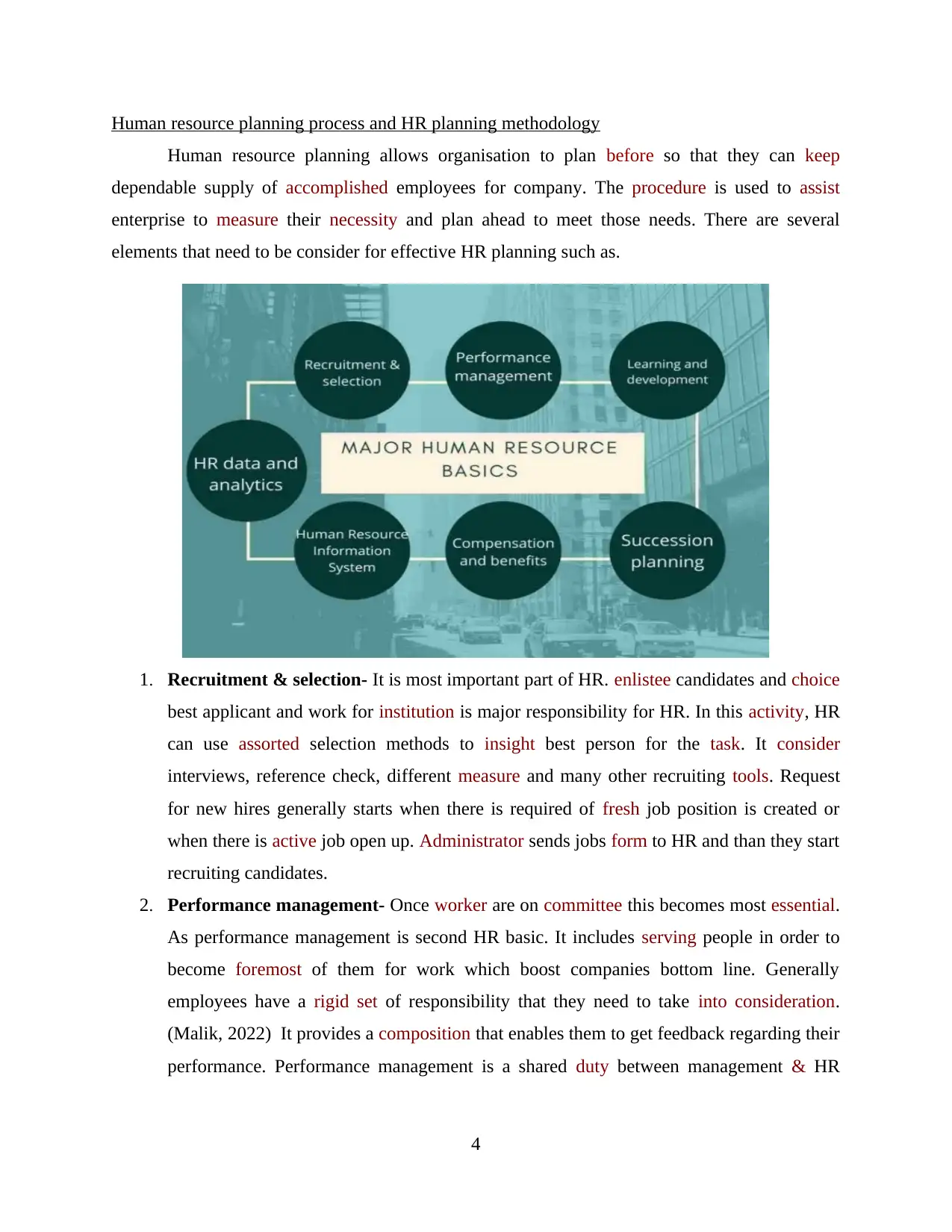
Human resource planning process and HR planning methodology
Human resource planning allows organisation to plan before so that they can keep
dependable supply of accomplished employees for company. The procedure is used to assist
enterprise to measure their necessity and plan ahead to meet those needs. There are several
elements that need to be consider for effective HR planning such as.
1. Recruitment & selection- It is most important part of HR. enlistee candidates and choice
best applicant and work for institution is major responsibility for HR. In this activity, HR
can use assorted selection methods to insight best person for the task. It consider
interviews, reference check, different measure and many other recruiting tools. Request
for new hires generally starts when there is required of fresh job position is created or
when there is active job open up. Administrator sends jobs form to HR and than they start
recruiting candidates.
2. Performance management- Once worker are on committee this becomes most essential.
As performance management is second HR basic. It includes serving people in order to
become foremost of them for work which boost companies bottom line. Generally
employees have a rigid set of responsibility that they need to take into consideration.
(Malik, 2022) It provides a composition that enables them to get feedback regarding their
performance. Performance management is a shared duty between management & HR
4
Human resource planning allows organisation to plan before so that they can keep
dependable supply of accomplished employees for company. The procedure is used to assist
enterprise to measure their necessity and plan ahead to meet those needs. There are several
elements that need to be consider for effective HR planning such as.
1. Recruitment & selection- It is most important part of HR. enlistee candidates and choice
best applicant and work for institution is major responsibility for HR. In this activity, HR
can use assorted selection methods to insight best person for the task. It consider
interviews, reference check, different measure and many other recruiting tools. Request
for new hires generally starts when there is required of fresh job position is created or
when there is active job open up. Administrator sends jobs form to HR and than they start
recruiting candidates.
2. Performance management- Once worker are on committee this becomes most essential.
As performance management is second HR basic. It includes serving people in order to
become foremost of them for work which boost companies bottom line. Generally
employees have a rigid set of responsibility that they need to take into consideration.
(Malik, 2022) It provides a composition that enables them to get feedback regarding their
performance. Performance management is a shared duty between management & HR
4
Paraphrase This Document
Need a fresh take? Get an instant paraphrase of this document with our AI Paraphraser
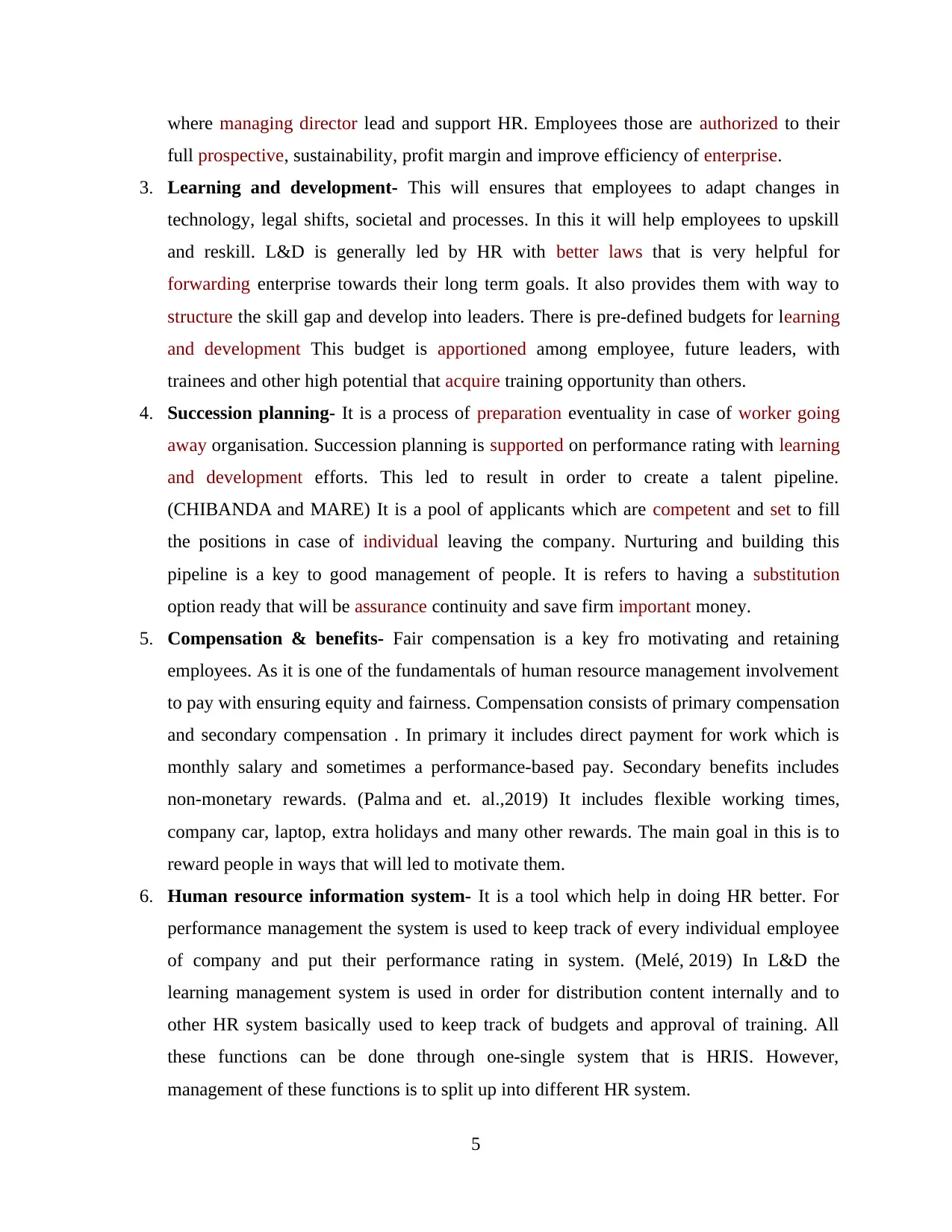
where managing director lead and support HR. Employees those are authorized to their
full prospective, sustainability, profit margin and improve efficiency of enterprise.
3. Learning and development- This will ensures that employees to adapt changes in
technology, legal shifts, societal and processes. In this it will help employees to upskill
and reskill. L&D is generally led by HR with better laws that is very helpful for
forwarding enterprise towards their long term goals. It also provides them with way to
structure the skill gap and develop into leaders. There is pre-defined budgets for learning
and development This budget is apportioned among employee, future leaders, with
trainees and other high potential that acquire training opportunity than others.
4. Succession planning- It is a process of preparation eventuality in case of worker going
away organisation. Succession planning is supported on performance rating with learning
and development efforts. This led to result in order to create a talent pipeline.
(CHIBANDA and MARE) It is a pool of applicants which are competent and set to fill
the positions in case of individual leaving the company. Nurturing and building this
pipeline is a key to good management of people. It is refers to having a substitution
option ready that will be assurance continuity and save firm important money.
5. Compensation & benefits- Fair compensation is a key fro motivating and retaining
employees. As it is one of the fundamentals of human resource management involvement
to pay with ensuring equity and fairness. Compensation consists of primary compensation
and secondary compensation . In primary it includes direct payment for work which is
monthly salary and sometimes a performance-based pay. Secondary benefits includes
non-monetary rewards. (Palma and et. al.,2019) It includes flexible working times,
company car, laptop, extra holidays and many other rewards. The main goal in this is to
reward people in ways that will led to motivate them.
6. Human resource information system- It is a tool which help in doing HR better. For
performance management the system is used to keep track of every individual employee
of company and put their performance rating in system. (Melé, 2019) In L&D the
learning management system is used in order for distribution content internally and to
other HR system basically used to keep track of budgets and approval of training. All
these functions can be done through one-single system that is HRIS. However,
management of these functions is to split up into different HR system.
5
full prospective, sustainability, profit margin and improve efficiency of enterprise.
3. Learning and development- This will ensures that employees to adapt changes in
technology, legal shifts, societal and processes. In this it will help employees to upskill
and reskill. L&D is generally led by HR with better laws that is very helpful for
forwarding enterprise towards their long term goals. It also provides them with way to
structure the skill gap and develop into leaders. There is pre-defined budgets for learning
and development This budget is apportioned among employee, future leaders, with
trainees and other high potential that acquire training opportunity than others.
4. Succession planning- It is a process of preparation eventuality in case of worker going
away organisation. Succession planning is supported on performance rating with learning
and development efforts. This led to result in order to create a talent pipeline.
(CHIBANDA and MARE) It is a pool of applicants which are competent and set to fill
the positions in case of individual leaving the company. Nurturing and building this
pipeline is a key to good management of people. It is refers to having a substitution
option ready that will be assurance continuity and save firm important money.
5. Compensation & benefits- Fair compensation is a key fro motivating and retaining
employees. As it is one of the fundamentals of human resource management involvement
to pay with ensuring equity and fairness. Compensation consists of primary compensation
and secondary compensation . In primary it includes direct payment for work which is
monthly salary and sometimes a performance-based pay. Secondary benefits includes
non-monetary rewards. (Palma and et. al.,2019) It includes flexible working times,
company car, laptop, extra holidays and many other rewards. The main goal in this is to
reward people in ways that will led to motivate them.
6. Human resource information system- It is a tool which help in doing HR better. For
performance management the system is used to keep track of every individual employee
of company and put their performance rating in system. (Melé, 2019) In L&D the
learning management system is used in order for distribution content internally and to
other HR system basically used to keep track of budgets and approval of training. All
these functions can be done through one-single system that is HRIS. However,
management of these functions is to split up into different HR system.
5
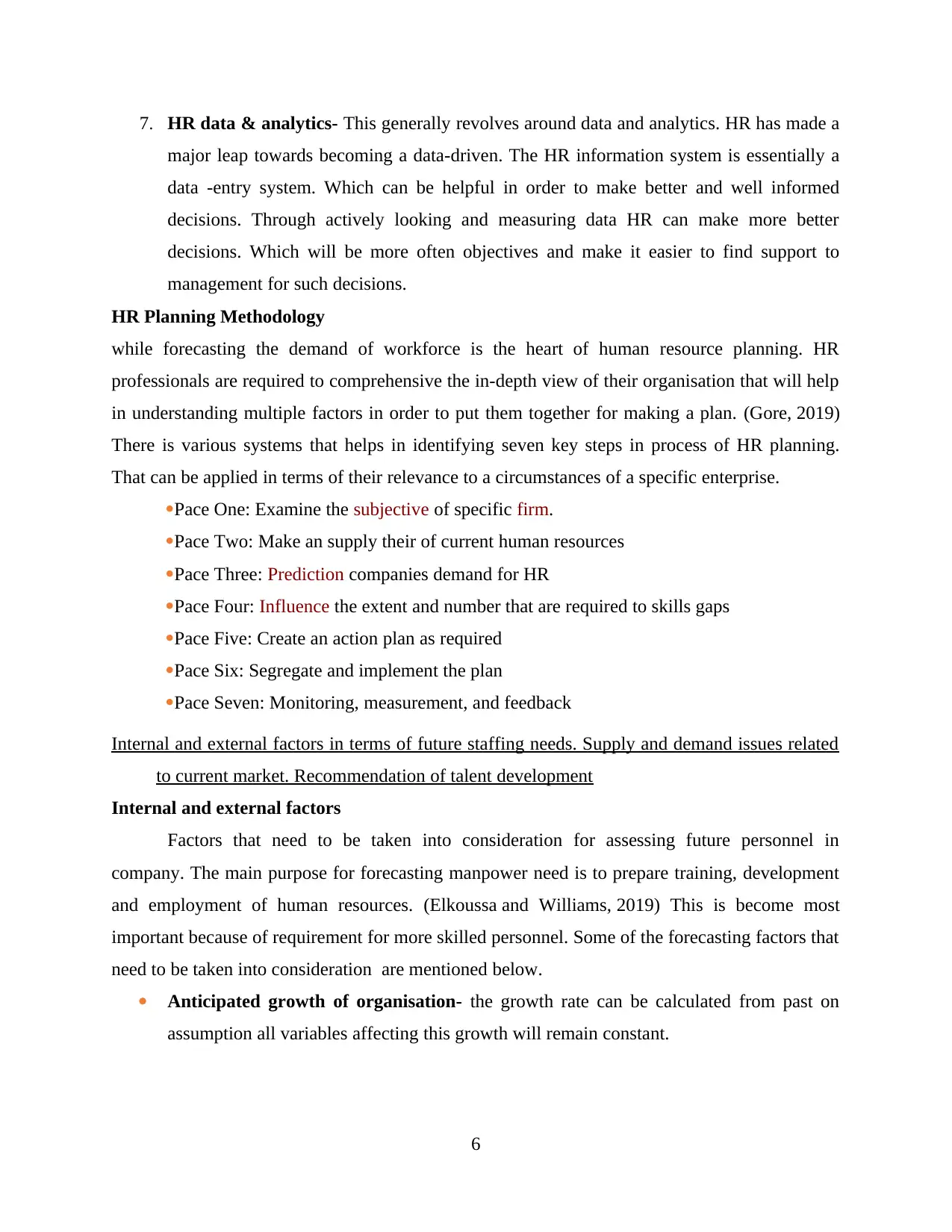
7. HR data & analytics- This generally revolves around data and analytics. HR has made a
major leap towards becoming a data-driven. The HR information system is essentially a
data -entry system. Which can be helpful in order to make better and well informed
decisions. Through actively looking and measuring data HR can make more better
decisions. Which will be more often objectives and make it easier to find support to
management for such decisions.
HR Planning Methodology
while forecasting the demand of workforce is the heart of human resource planning. HR
professionals are required to comprehensive the in-depth view of their organisation that will help
in understanding multiple factors in order to put them together for making a plan. (Gore, 2019)
There is various systems that helps in identifying seven key steps in process of HR planning.
That can be applied in terms of their relevance to a circumstances of a specific enterprise.
Pace One: Examine the subjective of specific firm.
Pace Two: Make an supply their of current human resources
Pace Three: Prediction companies demand for HR
Pace Four: Influence the extent and number that are required to skills gaps
Pace Five: Create an action plan as required
Pace Six: Segregate and implement the plan
Pace Seven: Monitoring, measurement, and feedback
Internal and external factors in terms of future staffing needs. Supply and demand issues related
to current market. Recommendation of talent development
Internal and external factors
Factors that need to be taken into consideration for assessing future personnel in
company. The main purpose for forecasting manpower need is to prepare training, development
and employment of human resources. (Elkoussa and Williams, 2019) This is become most
important because of requirement for more skilled personnel. Some of the forecasting factors that
need to be taken into consideration are mentioned below.
Anticipated growth of organisation- the growth rate can be calculated from past on
assumption all variables affecting this growth will remain constant.
6
major leap towards becoming a data-driven. The HR information system is essentially a
data -entry system. Which can be helpful in order to make better and well informed
decisions. Through actively looking and measuring data HR can make more better
decisions. Which will be more often objectives and make it easier to find support to
management for such decisions.
HR Planning Methodology
while forecasting the demand of workforce is the heart of human resource planning. HR
professionals are required to comprehensive the in-depth view of their organisation that will help
in understanding multiple factors in order to put them together for making a plan. (Gore, 2019)
There is various systems that helps in identifying seven key steps in process of HR planning.
That can be applied in terms of their relevance to a circumstances of a specific enterprise.
Pace One: Examine the subjective of specific firm.
Pace Two: Make an supply their of current human resources
Pace Three: Prediction companies demand for HR
Pace Four: Influence the extent and number that are required to skills gaps
Pace Five: Create an action plan as required
Pace Six: Segregate and implement the plan
Pace Seven: Monitoring, measurement, and feedback
Internal and external factors in terms of future staffing needs. Supply and demand issues related
to current market. Recommendation of talent development
Internal and external factors
Factors that need to be taken into consideration for assessing future personnel in
company. The main purpose for forecasting manpower need is to prepare training, development
and employment of human resources. (Elkoussa and Williams, 2019) This is become most
important because of requirement for more skilled personnel. Some of the forecasting factors that
need to be taken into consideration are mentioned below.
Anticipated growth of organisation- the growth rate can be calculated from past on
assumption all variables affecting this growth will remain constant.
6
⊘ This is a preview!⊘
Do you want full access?
Subscribe today to unlock all pages.

Trusted by 1+ million students worldwide

Budget constraints and allocations- It is specifically for all purpose in order to new
employees that will determine numbers of new workers that need to hired and, thus
putting them on ceiling for maximum number.
Minority hiring goals- Goals that need to be establish by company about hiring
minorities or handicapped people as a part of affirmative action polices that may affect
demand total number of employees. It is difficulty to match skills of such minority
workers for specific job requirements.
Anticipated internal turnover- This turnover of employees can be due to transfers,
promotions and transfers. As these numbers can be calculated to some extent accurately
through advance information about individuals. The turnover from retirement and
promotions can be accurately forecasting through preparing profiles of personnel that are
up for retirements, transfer or promotions in near future.
External factors
These factor can affect staffing ans strategic planning negatively or directly impacting on
profitability of company. Some of them are mentioned below.
Competitive factor- It is has no longer strictly a local issue but it is global issue. That
will directly affects the number of employees of company hires. Forecasting tools helps
in designing in order to assist organisation to deal with global competition that includes
consulting firms, trade association, research from university business department and
journalist business reports.(Jordan and et. al., 2019) All these resources can provide a
information that will help enterprise to decide how many people they need to hire offset
competitive force.
Environmental factor- It is a global environment issues that are significantly impacting
they way organisations are operating. Since the company is addressing all environmental
impacts related to business operation but still there are imperative work with this related
to operation. This may includes game and fish department, water boards and
environmental protection agency.
Supply and demand issues in current market
Demand for output- As the demand for employees needs increase both the
output and requirement will increase, as result demand for more labour will
7
employees that will determine numbers of new workers that need to hired and, thus
putting them on ceiling for maximum number.
Minority hiring goals- Goals that need to be establish by company about hiring
minorities or handicapped people as a part of affirmative action polices that may affect
demand total number of employees. It is difficulty to match skills of such minority
workers for specific job requirements.
Anticipated internal turnover- This turnover of employees can be due to transfers,
promotions and transfers. As these numbers can be calculated to some extent accurately
through advance information about individuals. The turnover from retirement and
promotions can be accurately forecasting through preparing profiles of personnel that are
up for retirements, transfer or promotions in near future.
External factors
These factor can affect staffing ans strategic planning negatively or directly impacting on
profitability of company. Some of them are mentioned below.
Competitive factor- It is has no longer strictly a local issue but it is global issue. That
will directly affects the number of employees of company hires. Forecasting tools helps
in designing in order to assist organisation to deal with global competition that includes
consulting firms, trade association, research from university business department and
journalist business reports.(Jordan and et. al., 2019) All these resources can provide a
information that will help enterprise to decide how many people they need to hire offset
competitive force.
Environmental factor- It is a global environment issues that are significantly impacting
they way organisations are operating. Since the company is addressing all environmental
impacts related to business operation but still there are imperative work with this related
to operation. This may includes game and fish department, water boards and
environmental protection agency.
Supply and demand issues in current market
Demand for output- As the demand for employees needs increase both the
output and requirement will increase, as result demand for more labour will
7
Paraphrase This Document
Need a fresh take? Get an instant paraphrase of this document with our AI Paraphraser
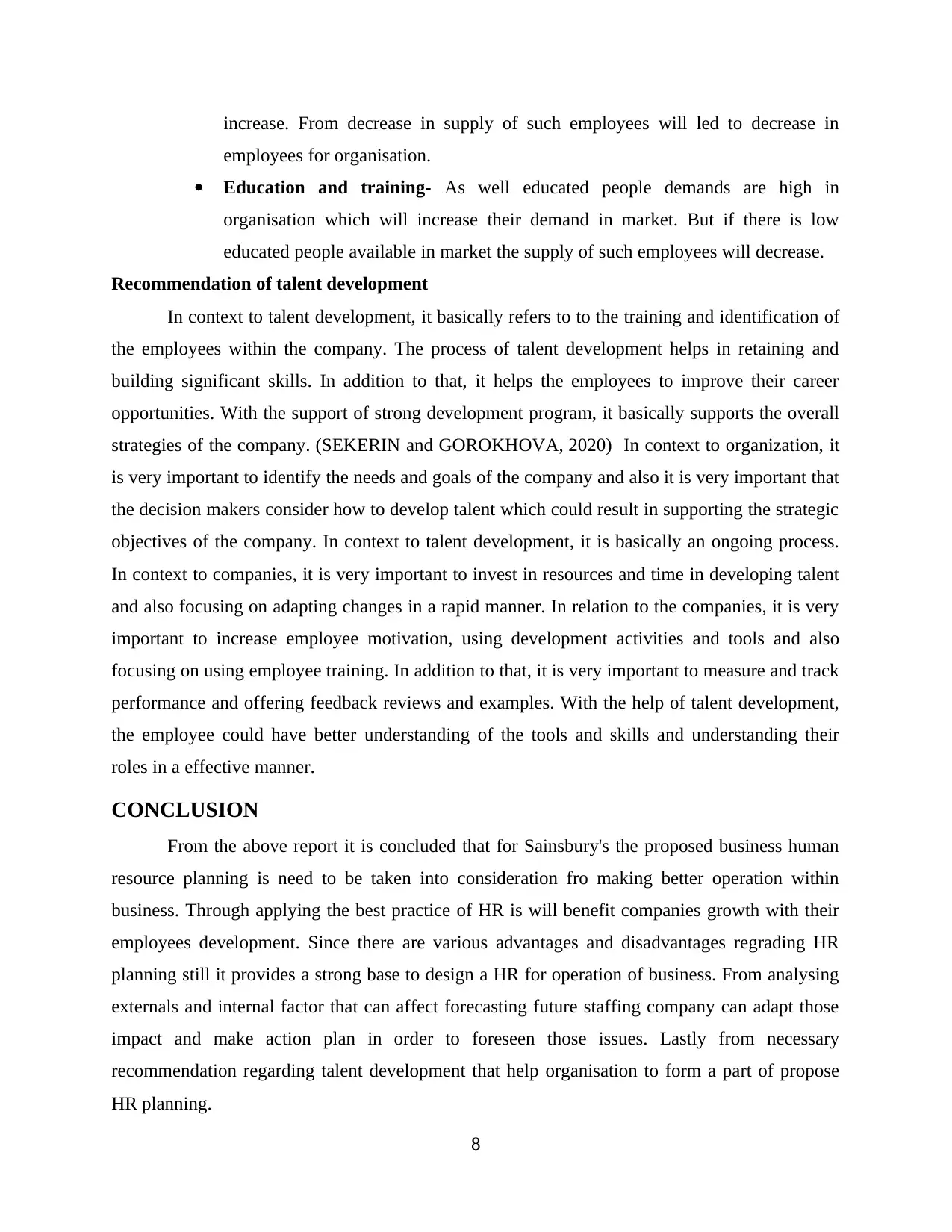
increase. From decrease in supply of such employees will led to decrease in
employees for organisation.
Education and training- As well educated people demands are high in
organisation which will increase their demand in market. But if there is low
educated people available in market the supply of such employees will decrease.
Recommendation of talent development
In context to talent development, it basically refers to to the training and identification of
the employees within the company. The process of talent development helps in retaining and
building significant skills. In addition to that, it helps the employees to improve their career
opportunities. With the support of strong development program, it basically supports the overall
strategies of the company. (SEKERIN and GOROKHOVA, 2020) In context to organization, it
is very important to identify the needs and goals of the company and also it is very important that
the decision makers consider how to develop talent which could result in supporting the strategic
objectives of the company. In context to talent development, it is basically an ongoing process.
In context to companies, it is very important to invest in resources and time in developing talent
and also focusing on adapting changes in a rapid manner. In relation to the companies, it is very
important to increase employee motivation, using development activities and tools and also
focusing on using employee training. In addition to that, it is very important to measure and track
performance and offering feedback reviews and examples. With the help of talent development,
the employee could have better understanding of the tools and skills and understanding their
roles in a effective manner.
CONCLUSION
From the above report it is concluded that for Sainsbury's the proposed business human
resource planning is need to be taken into consideration fro making better operation within
business. Through applying the best practice of HR is will benefit companies growth with their
employees development. Since there are various advantages and disadvantages regrading HR
planning still it provides a strong base to design a HR for operation of business. From analysing
externals and internal factor that can affect forecasting future staffing company can adapt those
impact and make action plan in order to foreseen those issues. Lastly from necessary
recommendation regarding talent development that help organisation to form a part of propose
HR planning.
8
employees for organisation.
Education and training- As well educated people demands are high in
organisation which will increase their demand in market. But if there is low
educated people available in market the supply of such employees will decrease.
Recommendation of talent development
In context to talent development, it basically refers to to the training and identification of
the employees within the company. The process of talent development helps in retaining and
building significant skills. In addition to that, it helps the employees to improve their career
opportunities. With the support of strong development program, it basically supports the overall
strategies of the company. (SEKERIN and GOROKHOVA, 2020) In context to organization, it
is very important to identify the needs and goals of the company and also it is very important that
the decision makers consider how to develop talent which could result in supporting the strategic
objectives of the company. In context to talent development, it is basically an ongoing process.
In context to companies, it is very important to invest in resources and time in developing talent
and also focusing on adapting changes in a rapid manner. In relation to the companies, it is very
important to increase employee motivation, using development activities and tools and also
focusing on using employee training. In addition to that, it is very important to measure and track
performance and offering feedback reviews and examples. With the help of talent development,
the employee could have better understanding of the tools and skills and understanding their
roles in a effective manner.
CONCLUSION
From the above report it is concluded that for Sainsbury's the proposed business human
resource planning is need to be taken into consideration fro making better operation within
business. Through applying the best practice of HR is will benefit companies growth with their
employees development. Since there are various advantages and disadvantages regrading HR
planning still it provides a strong base to design a HR for operation of business. From analysing
externals and internal factor that can affect forecasting future staffing company can adapt those
impact and make action plan in order to foreseen those issues. Lastly from necessary
recommendation regarding talent development that help organisation to form a part of propose
HR planning.
8
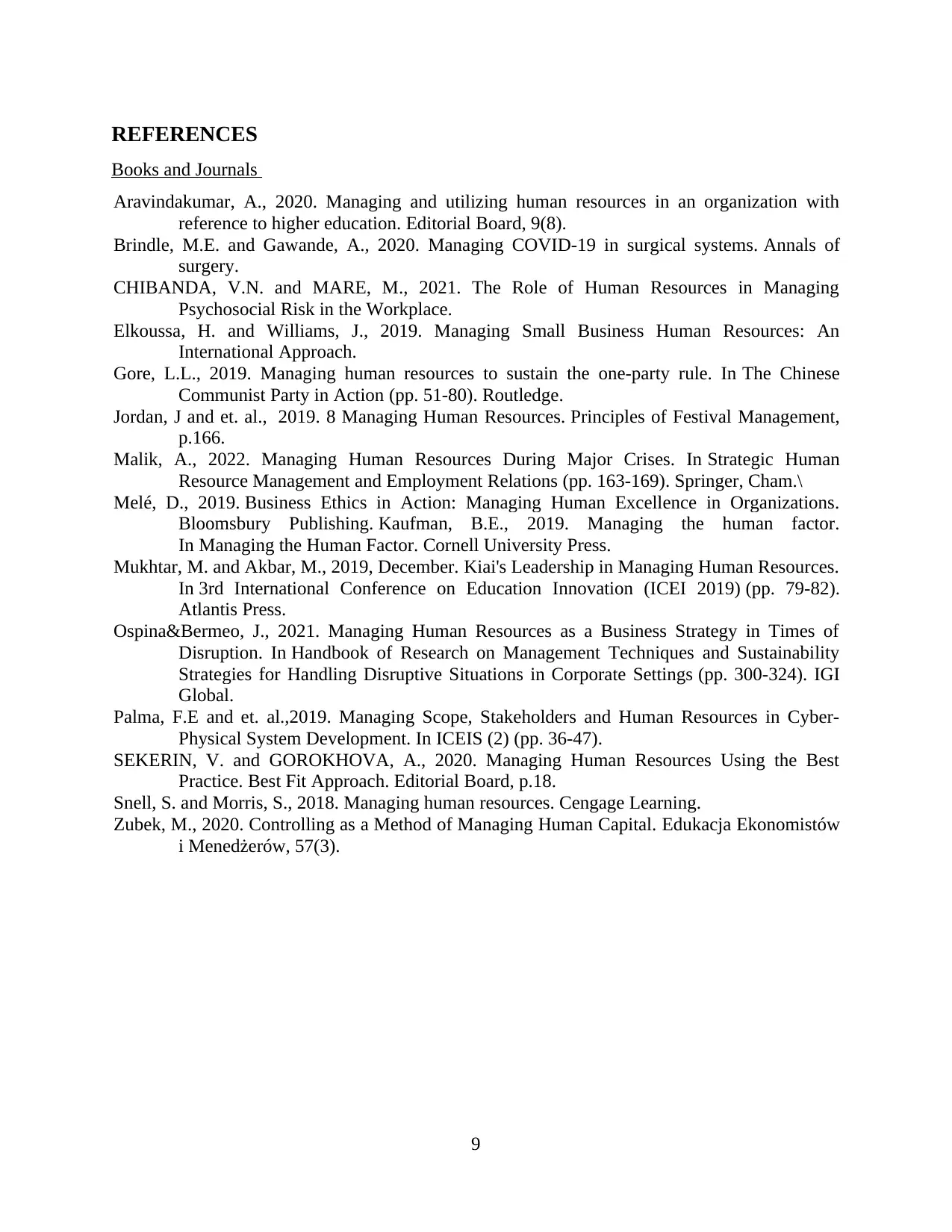
REFERENCES
Books and Journals
Aravindakumar, A., 2020. Managing and utilizing human resources in an organization with
reference to higher education. Editorial Board, 9(8).
Brindle, M.E. and Gawande, A., 2020. Managing COVID-19 in surgical systems. Annals of
surgery.
CHIBANDA, V.N. and MARE, M., 2021. The Role of Human Resources in Managing
Psychosocial Risk in the Workplace.
Elkoussa, H. and Williams, J., 2019. Managing Small Business Human Resources: An
International Approach.
Gore, L.L., 2019. Managing human resources to sustain the one-party rule. In The Chinese
Communist Party in Action (pp. 51-80). Routledge.
Jordan, J and et. al., 2019. 8 Managing Human Resources. Principles of Festival Management,
p.166.
Malik, A., 2022. Managing Human Resources During Major Crises. In Strategic Human
Resource Management and Employment Relations (pp. 163-169). Springer, Cham.\
Melé, D., 2019. Business Ethics in Action: Managing Human Excellence in Organizations.
Bloomsbury Publishing. Kaufman, B.E., 2019. Managing the human factor.
In Managing the Human Factor. Cornell University Press.
Mukhtar, M. and Akbar, M., 2019, December. Kiai's Leadership in Managing Human Resources.
In 3rd International Conference on Education Innovation (ICEI 2019) (pp. 79-82).
Atlantis Press.
Ospina&Bermeo, J., 2021. Managing Human Resources as a Business Strategy in Times of
Disruption. In Handbook of Research on Management Techniques and Sustainability
Strategies for Handling Disruptive Situations in Corporate Settings (pp. 300-324). IGI
Global.
Palma, F.E and et. al.,2019. Managing Scope, Stakeholders and Human Resources in Cyber-
Physical System Development. In ICEIS (2) (pp. 36-47).
SEKERIN, V. and GOROKHOVA, A., 2020. Managing Human Resources Using the Best
Practice. Best Fit Approach. Editorial Board, p.18.
Snell, S. and Morris, S., 2018. Managing human resources. Cengage Learning.
Zubek, M., 2020. Controlling as a Method of Managing Human Capital. Edukacja Ekonomistów
i Menedżerów, 57(3).
9
Books and Journals
Aravindakumar, A., 2020. Managing and utilizing human resources in an organization with
reference to higher education. Editorial Board, 9(8).
Brindle, M.E. and Gawande, A., 2020. Managing COVID-19 in surgical systems. Annals of
surgery.
CHIBANDA, V.N. and MARE, M., 2021. The Role of Human Resources in Managing
Psychosocial Risk in the Workplace.
Elkoussa, H. and Williams, J., 2019. Managing Small Business Human Resources: An
International Approach.
Gore, L.L., 2019. Managing human resources to sustain the one-party rule. In The Chinese
Communist Party in Action (pp. 51-80). Routledge.
Jordan, J and et. al., 2019. 8 Managing Human Resources. Principles of Festival Management,
p.166.
Malik, A., 2022. Managing Human Resources During Major Crises. In Strategic Human
Resource Management and Employment Relations (pp. 163-169). Springer, Cham.\
Melé, D., 2019. Business Ethics in Action: Managing Human Excellence in Organizations.
Bloomsbury Publishing. Kaufman, B.E., 2019. Managing the human factor.
In Managing the Human Factor. Cornell University Press.
Mukhtar, M. and Akbar, M., 2019, December. Kiai's Leadership in Managing Human Resources.
In 3rd International Conference on Education Innovation (ICEI 2019) (pp. 79-82).
Atlantis Press.
Ospina&Bermeo, J., 2021. Managing Human Resources as a Business Strategy in Times of
Disruption. In Handbook of Research on Management Techniques and Sustainability
Strategies for Handling Disruptive Situations in Corporate Settings (pp. 300-324). IGI
Global.
Palma, F.E and et. al.,2019. Managing Scope, Stakeholders and Human Resources in Cyber-
Physical System Development. In ICEIS (2) (pp. 36-47).
SEKERIN, V. and GOROKHOVA, A., 2020. Managing Human Resources Using the Best
Practice. Best Fit Approach. Editorial Board, p.18.
Snell, S. and Morris, S., 2018. Managing human resources. Cengage Learning.
Zubek, M., 2020. Controlling as a Method of Managing Human Capital. Edukacja Ekonomistów
i Menedżerów, 57(3).
9
⊘ This is a preview!⊘
Do you want full access?
Subscribe today to unlock all pages.

Trusted by 1+ million students worldwide
1 out of 12
Related Documents
Your All-in-One AI-Powered Toolkit for Academic Success.
+13062052269
info@desklib.com
Available 24*7 on WhatsApp / Email
![[object Object]](/_next/static/media/star-bottom.7253800d.svg)
Unlock your academic potential
Copyright © 2020–2025 A2Z Services. All Rights Reserved. Developed and managed by ZUCOL.




